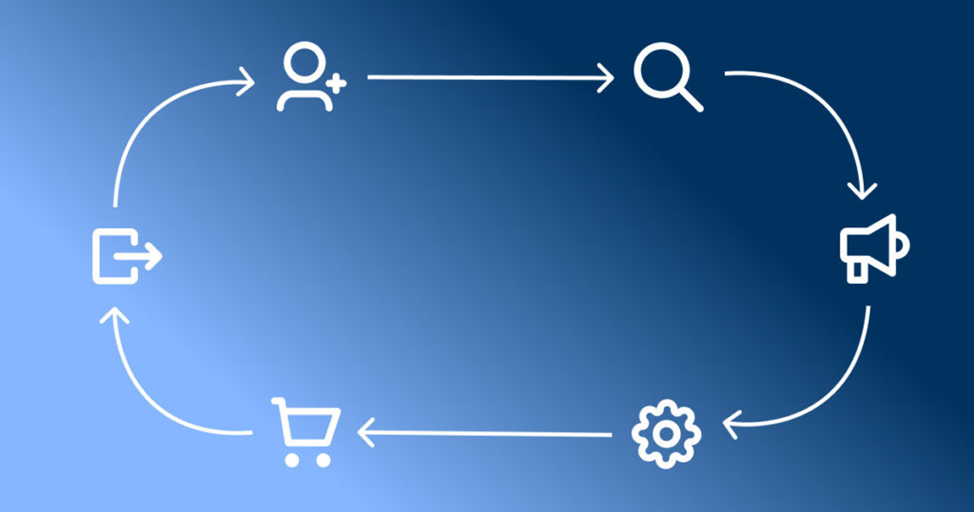Цикл продаж: что это такое, стратегии повышения конверсии
Что такое цикл продаж и почему он важен для вашего бизнеса?
Цикл продаж – это последовательность этапов, которые клиент проходит от момента первого контакта с компанией до завершения сделки или заключения контракта. Он представляет собой ключевой процесс, определяющий успешность взаимодействия с клиентами и достижение целей бизнеса. Цикл продаж важен для вашего бизнеса, особенно если вы работаете в сфере B2B, где взаимодействие с клиентами идет на более сложном и длительном уровне.
Цикл продаж в b2b
Этап 1: Генерация потенциальных клиентов
Первый этап цикла продаж в B2B – генерация потенциальных клиентов. На данном этапе компания активно привлекает новых потенциальных клиентов через различные B2B-каналы, такие как реклама, маркетинговые активности, контент-маркетинг, SEO и другие методы. Цель этого этапа заключается в привлечении потенциальных клиентов и заинтересовывании их продуктом или услугой компании.
Этап 2: Квалификация потенциальных клиентов
На втором этапе цикла продаж осуществляется квалификация потенциальных клиентов. Коммерческая команда проводит анализ и оценку интересующихся клиентов, чтобы определить, насколько они подходят под идеальный профиль клиента компании B2B. Квалификация позволяет сконцентрировать усилия на наиболее перспективных клиентах и предоставить более релевантные предложения в рамках бизнес-партнерства.
Этап 3: Презентация и демонстрация продукта/услуги
Третий этап цикла продаж – это презентация и демонстрация продукта или услуги потенциальным клиентам. Коммерческая команда предоставляет информацию о продукте или услуге, рассказывает о преимуществах и пользе, которую клиент может получить от сотрудничества. Демонстрация позволяет проиллюстрировать преимущества продукта и создать у клиента яркое впечатление о бизнес-партнерстве.
Этап 4: Предложение и переговоры
На этом этапе коммерческая команда представляет клиенту конкретное коммерческое предложение с учетом его потребностей и запросов в рамках бизнес-партнерства. Затем происходят переговоры, нацеленные на достижение взаимовыгодных условий для обеих сторон.
Этап 5: Заключение сделки и подписание контракта
После успешных переговоров и достижения взаимоприемлемых условий, клиент соглашается на сделку и подписывает контракт, что формально закрывает продажу в рамках бизнес-партнерства.
Этап 6: Удержание и развитие клиентов
После завершения сделки, компания продолжает поддерживать отношения с клиентом и обеспечивать высокий уровень обслуживания в рамках бизнес-партнерства. Удержание клиентов играет важную роль в сохранении стабильных и долгосрочных отношений, а также создает возможности для дальнейшего развития и роста бизнеса в рамках B2B.
Стратегии повышения конверсии на каждом этапе цикла продаж
Повышение конверсии на каждом этапе цикла продаж является одной из ключевых задач для успешного завершения сделки. Для этого можно применять различные стратегии и методы, направленные на улучшение эффективности работы с клиентами и увеличение шансов на успешное заключение сделки. Например, во время генерации потенциальных клиентов, использование таргетированной рекламы и контента с высокой степенью персонализации может привлечь более заинтересованных клиентов.
Квалификация потенциальных клиентов можно улучшить с помощью аналитики данных, которая позволяет выявлять более подходящих лидов для конверсии.
Презентация продукта или услуги станет более эффективной с использованием демонстраций и примеров, которые лучше отразят его преимущества и ценность для клиента. На этапе предложения и переговоров, фокусирование на взаимных интересах и предоставление гибких условий также может повысить вероятность успешного заключения сделки.
Наконец, удержание и развитие клиентов можно обеспечить высоким качеством обслуживания, персональным подходом и предложением дополнительных услуг или продуктов, соответствующих интересам клиента.
Автоматизация процесса продаж и использование CRM-систем
Автоматизация процесса продаж и использование CRM-систем (систем управления взаимоотношениями с клиентами) являются мощными инструментами для оптимизации и улучшения работы с клиентами на различных этапах цикла продаж. Автоматизация процесса продаж позволяет автоматизировать рутинные операции, упростить рабочие процессы и сосредоточиться на более важных аспектах взаимодействия с клиентами. CRM-системы обеспечивают единый доступ к информации о клиентах, позволяют отслеживать взаимодействие с ними, управлять контактами и предоставлять более персонализированный и качественный уровень обслуживания.
Методы и инструменты для анализа и оптимизации цикла продаж
Для анализа и оптимизации цикла продаж существует ряд эффективных методов и инструментов, которые помогают компаниям более глубоко понимать процесс взаимодействия с клиентами и выявлять возможности для улучшения и оптимизации. Один из таких методов – это аналитика данных. С помощью анализа данных компании могут получать информацию о поведении клиентов на различных этапах цикла продаж, определять тенденции и прогнозировать результаты. Это позволяет компаниям принимать обоснованные решения и строить более эффективные стратегии продаж.
Еще одним важным инструментом является использование метрик и ключевых показателей эффективности (KPI). Установление конкретных KPI на каждом этапе цикла продаж позволяет компаниям измерять и оценивать результативность своих усилий и выявлять места для улучшения. Например, KPI на этапе генерации потенциальных клиентов может быть связан с количеством и качеством лидов, а KPI на этапе предложения и переговоров – с конверсией и средним размером сделки. Это помогает компаниям более точно отслеживать эффективность каждого этапа и оптимизировать свои усилия.
Технологии автоматизации также играют важную роль в анализе и оптимизации цикла продаж. Системы управления взаимоотношениями с клиентами (CRM) позволяют компаниям централизованно хранить информацию о клиентах, их взаимодействии с компанией и истории сделок. Это упрощает анализ данных, обеспечивает единый доступ к информации и улучшает координацию работы коммерческой команды. Также с помощью CRM-систем возможно проводить анализ клиентской базы, выявлять сегменты клиентов и разрабатывать персонализированные подходы к взаимодействию.
Важным аспектом анализа и оптимизации цикла продаж является использование тестирования и экспериментов. Компания активно применяет методы A/B-тестирования для определения наиболее эффективных стратегий и тактик когда происходит продажа продукции. Эксперименты помогают выявить причинно-следственные связи и понять, какие изменения приводят к улучшению результатов.
Эффективное управление циклом продаж и применение оптимизационных методов и инструментов помогают компаниям повысить конверсию, улучшить клиентский опыт и обеспечить стабильный рост и успех в сфере бизнеса.
Эксперт в области интернет-маркетинга. Руководитель маркетингового агентства MAVR.
Бизнес-степень «Мастер делового администрирования» (MBA).



